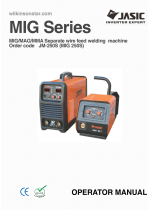
TABLE OF CONTENTS
0459 287 474 © ESAB AB 2016
1 INTRODUCTION................................................................................................... 4
1.1 Do this first ........................................................................................................... 4
1.2 Control panel's working method ........................................................................5
1.3 Control panel ........................................................................................................ 5
1.4 Symbols in the display ........................................................................................ 6
2 MENUS ................................................................................................................. 7
2.1 The main menu and the measurements menu ..................................................7
2.2 The selection menu..............................................................................................7
3 MIG/MAG WELDING ............................................................................................ 8
3.1 Settings ................................................................................................................. 8
3.2 Function explanations .......................................................................................10
4 TIG WELDING..................................................................................................... 14
4.1 Overview ............................................................................................................. 14
4.2 Settings ............................................................................................................... 14
4.3 Function explanations .......................................................................................15
5 MMA WELDING.................................................................................................. 20
5.1 Settings ............................................................................................................... 20
6 ARC-AIR GOUGING ........................................................................................... 22
6.1 Settings ............................................................................................................... 22
7 GENERAL FUNCTIONS ..................................................................................... 23
7.1 Remote control unit ........................................................................................... 23
7.2 Settings ............................................................................................................... 23
8 MEMORY MANAGEMENT ................................................................................. 24
8.1 Store welding data ............................................................................................. 24
8.2 Recall welding data............................................................................................ 25
8.3 Delete welding data............................................................................................26
9 LOCK CODE....................................................................................................... 27
10 FAULT CODES ................................................................................................... 28
10.1 General................................................................................................................ 28
10.2 List of fault codes ..............................................................................................28
10.3 Fault code descriptions..................................................................................... 29
11 ORDERING SPARE PARTS ............................................................................... 34
DIAGRAM ..................................................................................................................35
WIRE AND GAS DIMENSIONS.................................................................................36





















